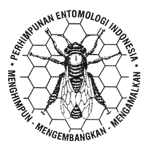Status dan Mekanisme Resistensi Biokimia Crocidolomia pavonana (F.) (Lepidoptera: Crambidae) terhadap Insektisida Organofosfat serta Kepekaannya terhadap Insektisida Botani Ekstrak Biji Barringtonia asiatica
DOI:
https://doi.org/10.5994/jei.7.1.9Keywords:
resistance, enzyme, organophosphat, botanical insecticideAbstract
An examination of insect resistance was determined by several steps, i.e. standard sensitivity, resistance diagnosis, and determination of resistance level. Each phase was tested with feeding and residue contact methods at glass tube. Resistance ratio (RR) was determined by comparing LC50 value of field population with standard population. Field population of C. pavonana was classified resistant if it had RR 5 4. Biochemistry analysis of resistance was conducted to population of C. pavonana showing resistance to prophenophos insecticide. The activity analysis of acetylcholine esterase (ACHE), esterase, and Glutation Stransferase was done with spectrophotometer method. Insect which are resistant to prophenophos insecticide was tested for its sensitivity to Barringtonia asiatica seed extract. Result indicated that C. pavonana population from Pengalengan showed resistance to prophenophos synthetic insecticide. Using contact test, the highest resistance ratio value was 4.04, while by feeding assay the RR was 2.78. The study on biochemical resistance mechanisms of each field population of C. pavonana showed various activities of enzymatic detoxification. This could be due to the difference in the kind of insecticides exposed to each field population of C. pavonana. Since RR value from the contact test was higher than that of the feeding test, the resistance development of C. pavonana to synthetic insecticides was probably caused by physiological and biochemical changes in insect cuticle rather than the activity of detoxification enzyme. Methanolic seed extract of B. asiatica can be used as an alternative of resistance management of C. pavonana to prophenophos synthetic insecticide.Downloads
Downloads
Published
How to Cite
Issue
Section
License
Authors who publish with this journal agree to the following terms:
- Authors retain copyright and grant the journal right of first publication with the work simultaneously licensed under a Creative Commons Attribution 4.0 International License that allows others to share the work with an acknowledgement of the work's authorship and initial publication in this journal.
- Authors are able to enter into separate, additional contractual arrangements for the non-exclusive distribution of the journal's published version of the work (e.g., post it to an institutional repository or publish it in a book), with an acknowledgement of its initial publication in this journal.
- Authors are permitted and encouraged to post their work online (e.g., in institutional repositories or on their website) prior to and during the submission process, as it can lead to productive exchanges, as well as earlier and greater citation of published work (See The Effect of Open Access).








